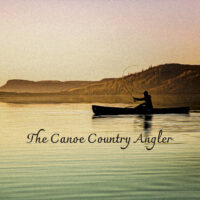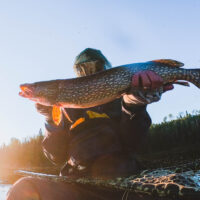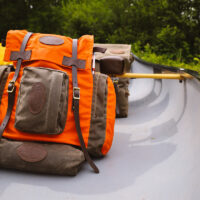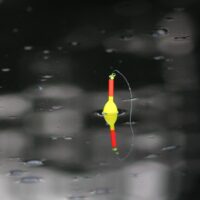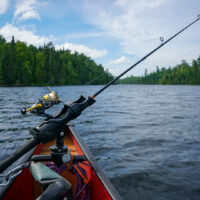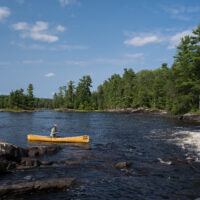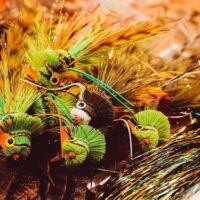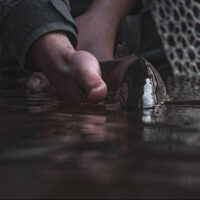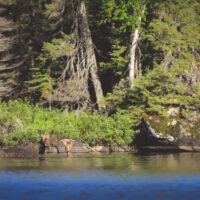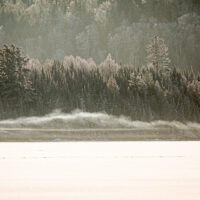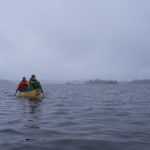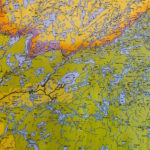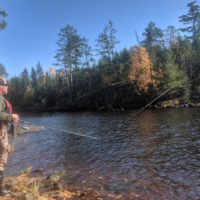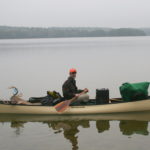Early Ice Safety & Wonky Winter Weather
December 26, 2023 12:23 pmby SFBW staff
Early ice can be one of the most productive times to ice fish, but with that comes additional safety considerations that one must consider before heading out for those first bites of the winter. As the open water starts to glaze over, the allure of that first ice bite is hard to resist, even when the weather is as wonky as it’s been so far this winter.
In many cases, fish are still clinging to their late fall behavior and areas as they slowly shift into winter patterns. Being one of the first to target these fish through the ice can be quite a thrill, and if you plan to venture onto that early ice, here are a few safety precautions to keep in mind.
Ice Thickness
Determining the least thick amount of ice, you are comfortable walking on is ultimately a personal choice. Still, as a good rule of thumb, 4 inches is considered safe for walking, with about 6 inches being accepted as safe for small machines such as snowmobiles (NOT VEHICLES). Many anglers push their ice limits thinner than 4 inches, but don’t let others determine your safety – just because someone else is on the ice doesn’t mean it’s safe, and remember, no ice is safe ice, so always be cautious and aware. Modern Carnivore does a great job of explaining how to determine safe ice in this YouTube video.
Checking the Ice
The Boundary Waters is one of few places where your odds of being the first person on a given piece of ice are fairly high, but even with a trusted report, you should always check the ice as you make your way out. To do so, one of the best tools you can have is a spud bar. A good way to check ice with a spud bar is to drive the chisel end into the ice out in front of you with a stabbing motion with every other step. To be very thorough, utilize your auger and measure the ice as you go along and keep in mind that even if you’re getting consistent ice of 4” or thicker, that doesn’t mean that ice elsewhere on the same body of water can’t be thinner. You may find yourself hitting 5” of ice with your spud bar for hundreds of yards and all of a sudden break through 2”. This can result from many factors, often from underwater currents or river inlets that aren’t necessarily obvious when the lake is frozen over. Don’t get lazy, and keep on spuddin’ your way along!

Gear
There are a few pieces of gear that can keep a bad situation on the ice from turning into a much darker (and colder) one. Most people who have a fatal outcome from falling through the ice die from drowning, so a flotation device should always be on your person. For years, people have worn life jackets out on the ice, but brands such as Striker now make ice fishing suits with built-in flotation technology. These suits not only act as safety devices but are extremely comfortable in the conditions and help keep your base layers nice and dry after a day of fishing.
Speaking of base layers, it is important that you remember the timeless adage, “cotton kills!” While cotton clothing will absorb moisture and be very difficult to dry out, wool clothing will stay warm even when soaked through. There are excellent options ranging from military surplus wool to advanced merino wool technology from our friends at First Lite. When buying clothing for ice fishing, consider your safety in an emergency situation, but also how comfortable you can be in the elements for an extended period of time. Falling through the ice isn’t the only way to find yourself in a dangerous situation, especially in the backcountry.
Along with a spud bar, having a pair of ice picks around your neck is imperative. If you do go through, climbing out without picks is nearly impossible. These can be purchased at most outdoor stores and shouldn’t cost more than $20.
A rope in your sled is a must. If you, your fishing partner, or another person on the ice goes through, you don’t want to try to pull them up with your arms, as the ice you fell through will most likely not support both your weight. Toss them a rope from a distance, have them tie it around themselves immediately, and then pull as they kick their legs so that you don’t go through with them. Remember, it isn’t a tug of war. If they start to pull you in, let go! Try again.
Things to Avoid
Online/Social Media ice reports from uncredited sources! Not only are ice reports from social media sources not always accurate, but you have no idea of where on the lake they checked the ice. Use these forums to get an idea of the conditions; this may prevent you from making a long drive for nothing, but take them with a grain of salt. A safer but still imperfect bet is to call local bait shops for the latest ice reports. While you should check the ice as you go, most local shops want everyone to be safe and will air on the side of caution.
Here’s a list of additional considerations and potential dangers when heading out on the ice!
- Open water
- Melting shore ice
- Areas where flowing water (rivers, streams, etc) enters the lake
- High winds
- Pressure Ridges
- Honeycomb ice
- Shelf ice
What to do if you Fall In
If you fall in, knowing what to do and having a plan is crucial. The Minnesota DNR and popular YouTube angler Uncut Angling have done a fantastic job of explaining what to do in the worst-case scenario on the ice.
At the end of the day, no fish is worth dying for. Yes, even that 40” Lake Trout isn’t worth it, as much as we’d all love to tie up with one of those. The good news is that you can be the first angler on the ice, and you can get the grip and grin with an early ice monster, but safety must be paramount above all else. Check the ice, do your research, be safe, and keep a tight line.


